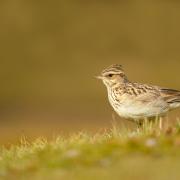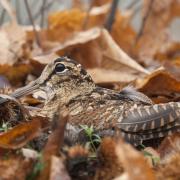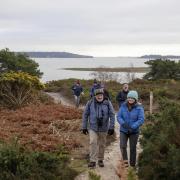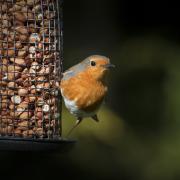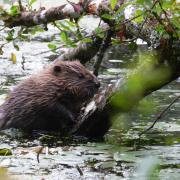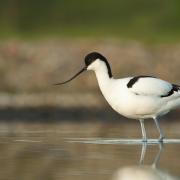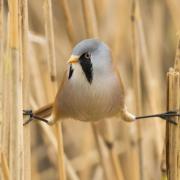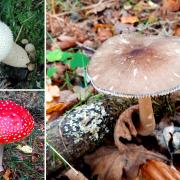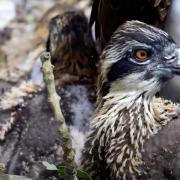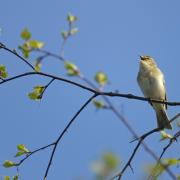Colin Varndell's glorious photo essay gives us the opportunity to get a favoured view of what are probably Dorset's shyest residents - the roe, white fallow, sika, and muntjac deers.November 08
A man approached me in a West Dorset pub and excitedly told how, when walking on Powerstock Common a few days previously, he and his wife had stumbled upon a baby roe deer. I immediately expressed concern and said how I hoped they had not gone near to the kid. The man explained how they had first thought there was something wrong with the fawn and had only stroked it. That young roe kid would have subsequently starved to death because its mother, when detecting human scent on or even near it would have rejected her offspring.
Although deer are common throughout Dorset it is still a great thrill to see them. Wild deer are shrouded in myth and are secretive in their ways and habits, and our fleeting glimpses of them are seldom more than just that. There are four species of deer regularly seen in Dorset but it is only the roe which is native. Roe deer are very much woodland dwellers and wherever mature woodland backs on to peaceful, grassy fields they will be present. The bucks grow their antlers in early summer, ready for the rut which occurs during August. A buck, disturbed by humans, will run off into the forest echoing its fierce sounding husky bark as a sign to other deer that danger is nearby. Usually, it will continue barking frequently until well off into the distance.
Roe are the only true native deer to Dorset. Feeding takes place mostly at dawn and dusk although they may be encountered in lush fields in the middle of the day. Unlike the boisterous sika or the noisy fallow, you are unlikely to witness bouts of antler clashing between rival bucks during the rut as these contests usually take place in deep cover. Throughout the rut, a mature buck will usually devote his attentions to a single doe as this species is largely monogamous.
The fawns or kids (often twins) are born in May or June and are left hiding in long grass or bracken during daytime. Their mothers return to them around sunset. Fawns discovered lying in vegetation are not abandoned and must always be left undisturbed.
The white fallow deer of Powerstock Common are always exciting to spot. They occur throughout the herd and it is not unusual to see more than two white individuals together. I once watched a herd of 50 fallow grazing on farmland beneath Eggardon Hill on a winter afternoon and noted that seven of them were white. These deer at Powerstock are known as 'Old English fallow' and it is understood that they may have been introduced for sport in Roman times. Unlike park fallow deer, the wild deer of Powerstock are dark in colour almost to the point of black in some cases. The herd is mainly centred around Powerstock Common but individuals may be encountered anywhere within a circle which takes in Loders, Toller Porcorum, Rampisham and Beaminster.
The mature (four years or older) buck dons a flattened, palmate antler which is regularly toothed or snagged. In the autumn, these mature bucks gather their harems of does around them for the mating or rutting season to commence as the does become receptive. The rut lasts for about one month, reaching a peak in mid-October. During this time, females aged two or more become pregnant and the fawns are born the following May or June.
The sika deer were first introduced on to Brownsea Island in the late 1800s, but they soon waded or swam across to the mainland at low tide and established a breeding herd on the salt marsh and woodland around the edge of Poole Harbour. They are especially easy to observe at the Arne RSPB reserve where they have become accustomed to people.
The most highly successful deer in Dorset are the sika, which have spread rapidly across the county in recent years. Although they have traditionally shown a preference for the acid soils of East Dorset, they are now appearing in the west of the county. Their success is also their demise as their avaricious grazing eventually destroys understorey in woodland, turning an otherwise rich forest habitat into meagre wood pasture. The sika herd has also put pressure on the salt marshes of the Poole basin where the habitat is threatened by their over-indulgence. For these reasons sika deer in Dorset are culled to ensure these habitats are maintained and the herd remains healthy.
There are times when deer can become dangerous and this is most likely during the autumn rut when testosterone runs high. I remember one of the wardens at Powerstock Common telling me how a roe buck had charged him and knocked him over. Another more recent story tells how an over-enthusiastic photographer got too close to a sika stag and was promptly lifted onto the top of a gorse bush!
I once parked my car close to a bird-feeding area in the car park at Arne. I returned to find sika deer close to my car feeding on the birdseed. The stag would not allow me to approach my car and each time I attempted to he came toward me with his antlers lowered.
There have been increasing reports of sightings on muntjac deer in Dorset in recent years. From personal experience, I saw a muntjac buck in a field alongside the coast road near Swyre about a year ago. These small deer were first introduced to deer parks from the Far East and have escaped to establish a widespread breeding population across the south-east of England.
Muntjac do not have a regular rutting season like our other three species as continuous breeding occurs with mating taking place soon after the birth of fawns. Muntjac also tend to be more solitary and secretive in their habits, feeding mainly at dusk and remaining deep in cover during daylight hours. With these secretive tendencies in mind, it may well be that there are far more of this species in Dorset than we think there are.
The wild deer of Dorset are beautiful and majestic creatures, and they have done well to survive the onslaught of human activity. The daily dangers deer encounter are many, but their shy and secretive way has helped maintain their survival, and will continue to do so;







